Ten things we learned in the 2014 fantasy football season

With the fantasy season all but behind us and the holidays in full gear, we’ll spend much of the next two weeks putting a bow on the year that was in fantasy football. Four months ago, we kicked off the season after a summer spent prognosticating, ranking and debating the fantasy prospects of every relevant player in the league. In the 16 weeks that followed, we learned a lot about the individual players and merits of certain strategies. Every season will be different, but fantasy owners will do well for themselves by taking the lessons laid bare this season and filing them away for next season.
Every year at this time, I come back to one of my favorite quotes from Abraham Lincoln: "I do not think much of a man who is not wiser today than he was yesterday."
They may not have had fantasy football in the mid-nineteenth century, but Lincoln could have been speaking right to the fantasy owners of the present day with that utterance. Be wiser tomorrow than you are today. Be wiser in 2015 than you were in '14. Take the following 10 lessons we learned this season with you into next year.
There’s still nothing better than a stud running back
DeMarco Murray and Le’Veon Bell were easily the two best running backs in fantasy football leagues this year. Bell just edged Murray in fantasy points, but both backs were freakishly consistent. They both failed to reach double digits just once while eclipsing 20 points six times. Bell made an art form of the big game late in the season, going north of 25 points three times, 30 points twice and 40 points once. Murray and Bell each averaged just shy of 19 points per game. Arian Foster, meanwhile, was a touch over 19 points per game, but missed four contests due to injury.
Fantasy Fast Forward: Bell's record day lifts Steelers and owners alike
While the wide receiver position has made strides against running backs over the last five years, a stud running back is still king in fantasy leagues. The top wide receiver on a per-game basis was Odell Beckham Jr., who scored 15.3 points in an average week. Antonio Brown was the No. 1 overall receiver, putting up 15.2 points per game. That means that Murray, Bell and Foster were nearly 25 percent more productive than the very best wide receivers in an average week. Even if you assume that the top backs get taken with the first couple picks, something that wasn’t the case for Murray, Bell or Foster, the difference in draft position doesn’t nearly close the yawning gap in points per game.
Wide receivers may be more important than ever, but there’s remains nothing more dangerous than a star at the running back position.
Running backs were more predictable than anyone expected
The top-10 running backs in standard-scoring fantasy leagues, in order, were Bell, Murray, Marshawn Lynch, Matt Forte, Foster, Eddie Lacy, Jamaal Charles, Justin Forsett, Jeremy Hill and Alfred Morris. Six of those guys were in the top 10 in average draft position, and two others, Bell and Morris, were just outside. The only high-priced backs to bust were LeSean McCoy and Adrian Peterson. Peterson’s downfall was, of course, completely unpredictable, making McCoy the only true bust among the first-round running backs.
To be sure, there were plenty of misses in the second and third rounds. Zac Stacy, Doug Martin, Giovani Bernard, Reggie Bush, Ryan Mathews and C.J. Spiller all disappointed this year for a variety of reasons. However, we knew that they all had red flags entering the season, as does any back at that range of the draft in any year. If you took a back not named McCoy or Peterson with your first or second pick, you were likely satisfied with their production.
2014 Fantasy Football All-Pro Team
QB: Andrew Luck (IND)
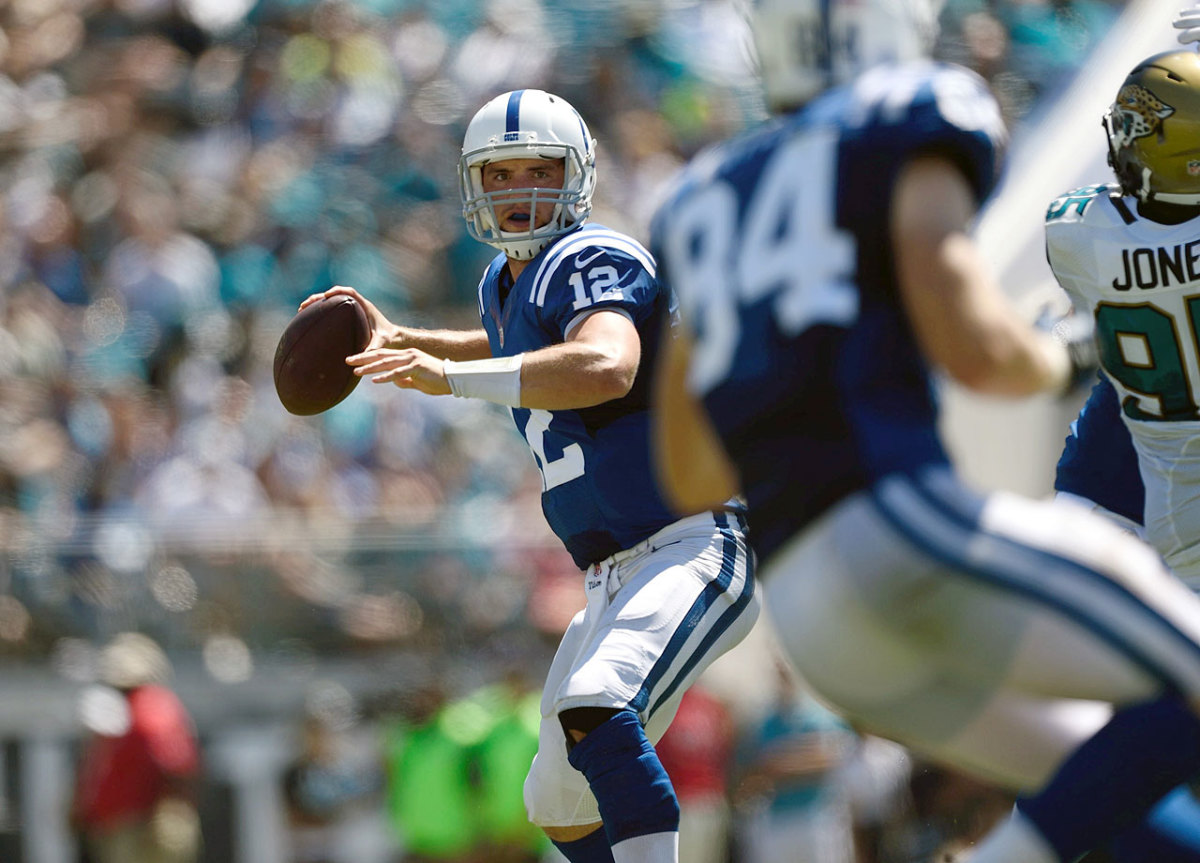
Passing: 4,011 yards, 34 TDs, 11 Ints | Rushing: 213 yards, 2 TDs
RB: DeMarco Murray (DAL)
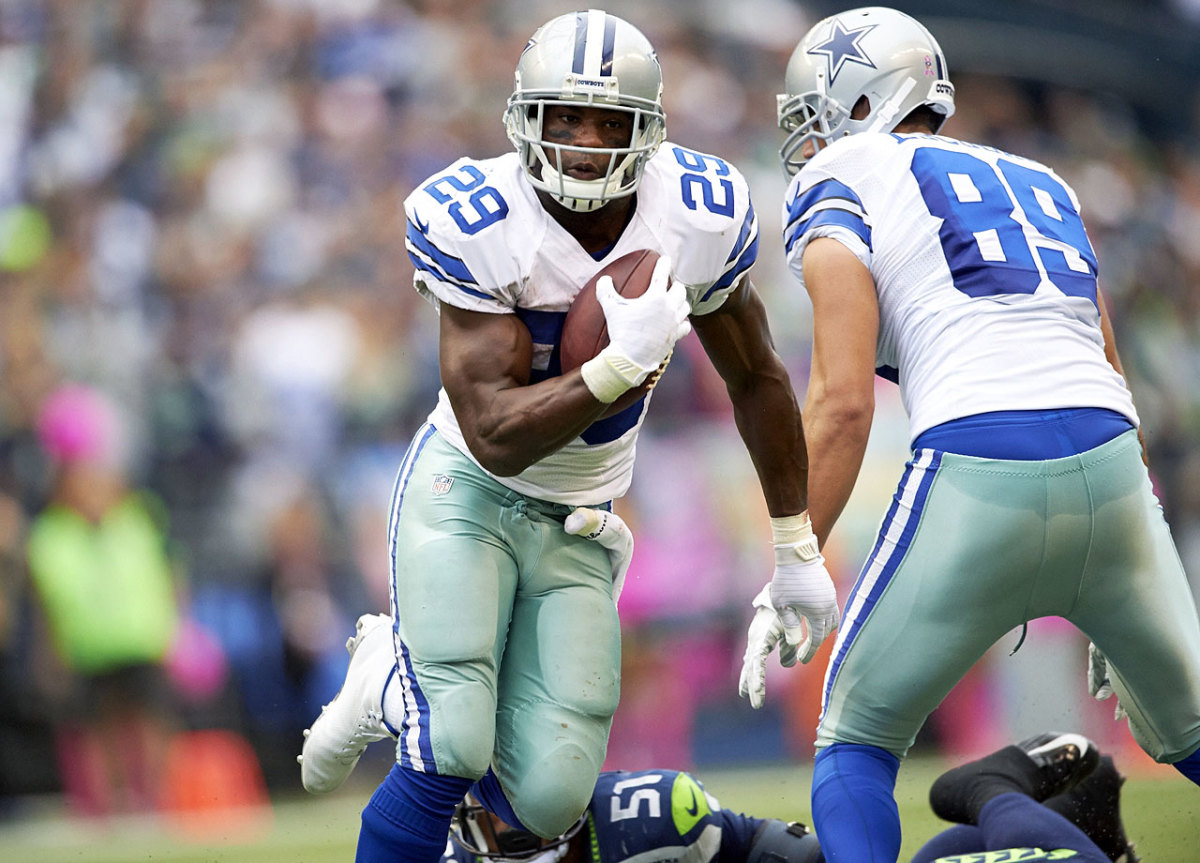
Rushing: 1,427 yards, 8 TDs | Receiving: 44 receptions, 343 yards
RB: Le’Veon Bell (PIT)
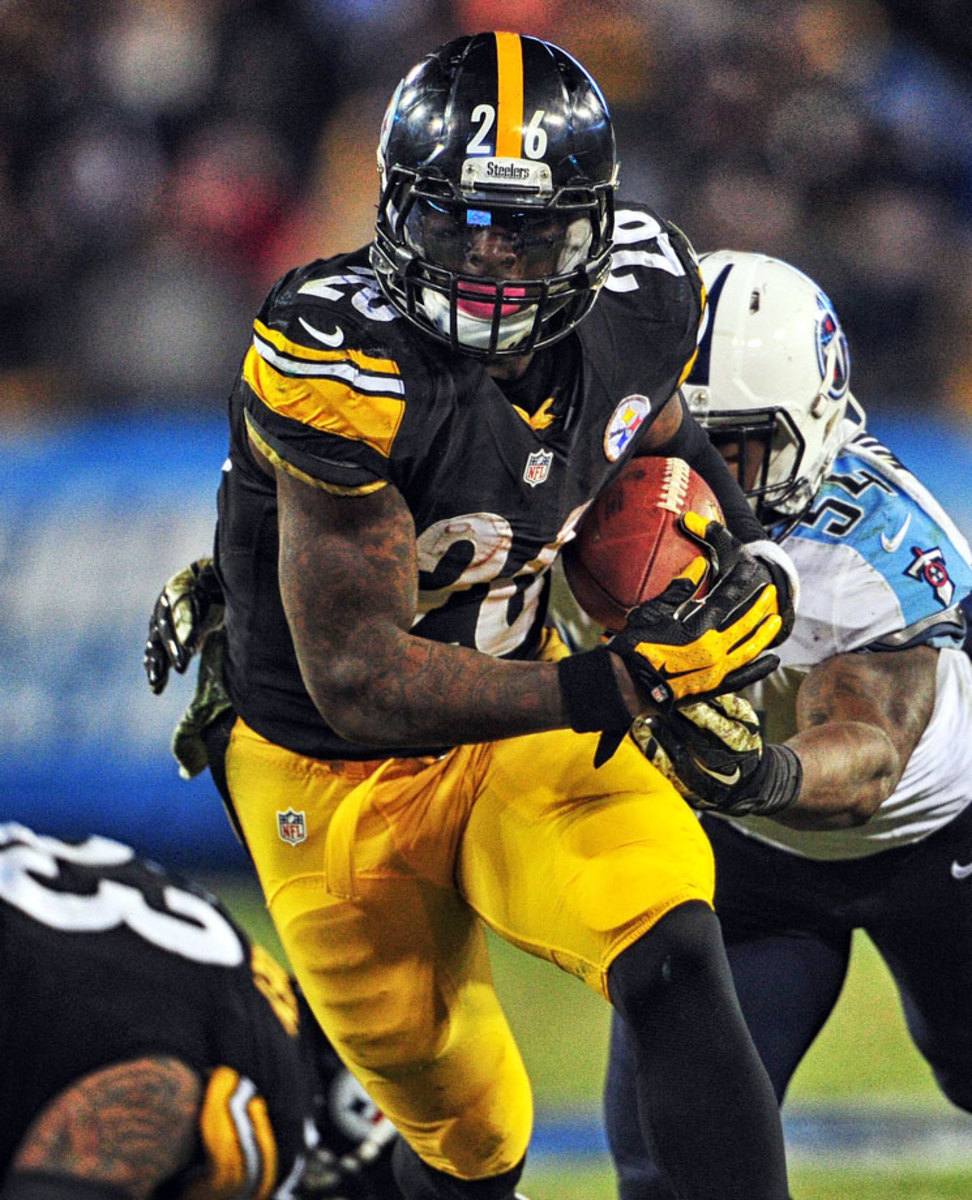
Rushing: 1,046 yards, 3 TDs | Receiving: 65 receptions, 643 yards, 2 TDs
WR: Antonio Brown (PIT)
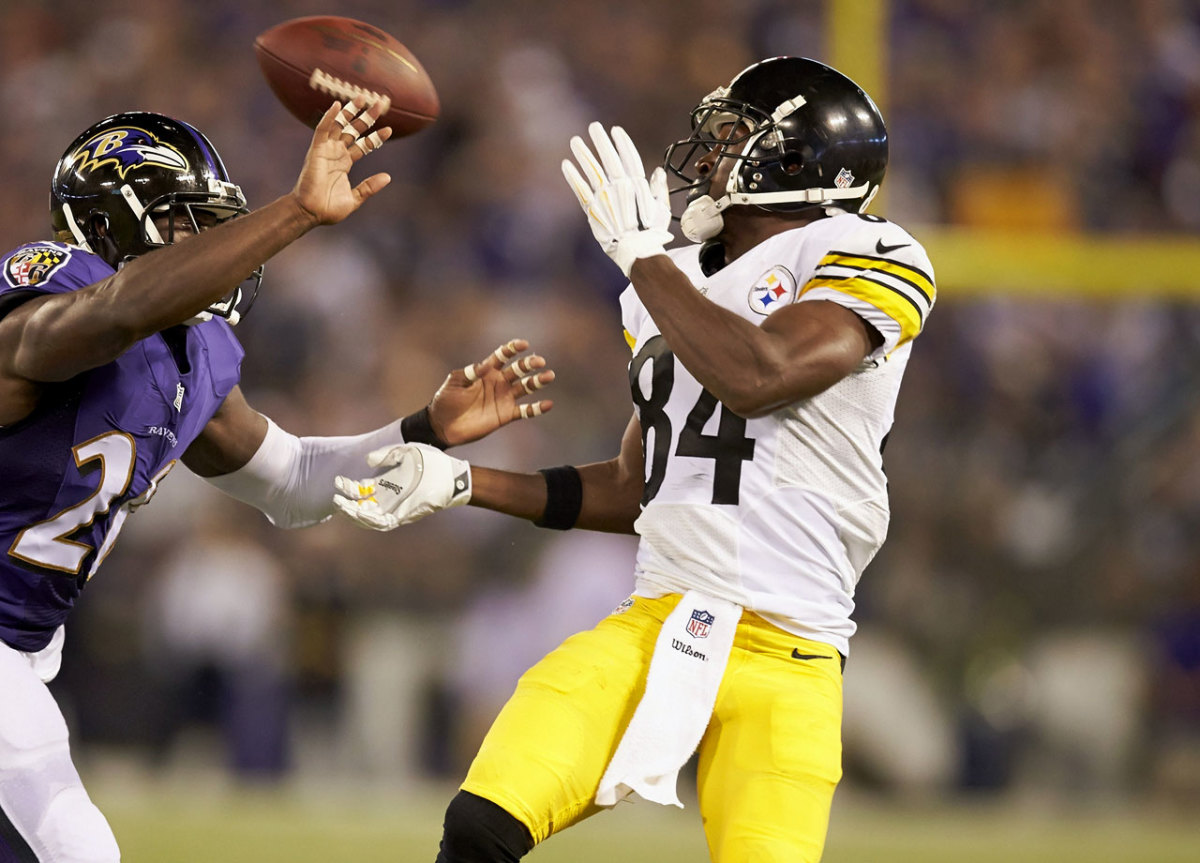
Receiving: 96 receptions, 1,258 yards, 11 TDs, 1 2PT | Rushing: 13 yards | Passing: 20 yards, 1 TD
WR: Demaryius Thomas (DEN)
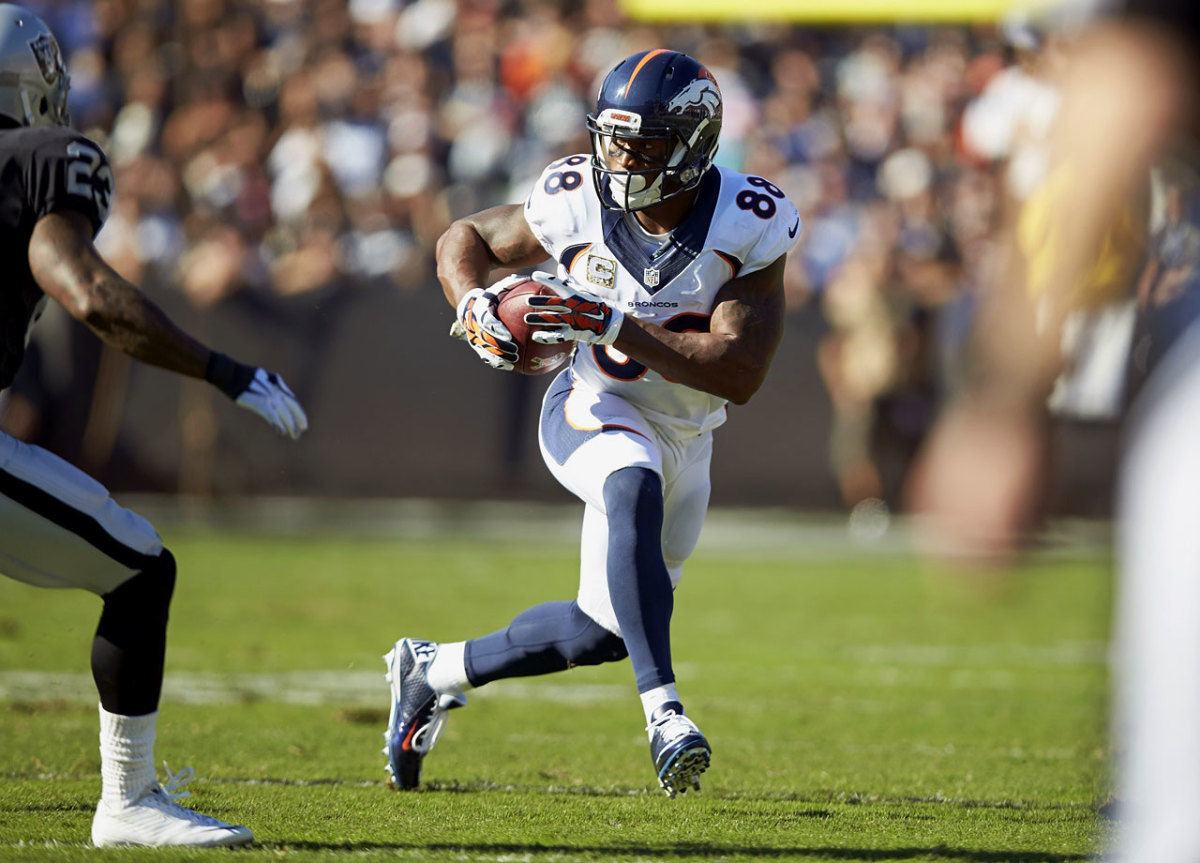
Receiving: 88 receptions, 1,255 yards, 10 TDs, 1 2PT
WR: Jordy Nelson (GB)
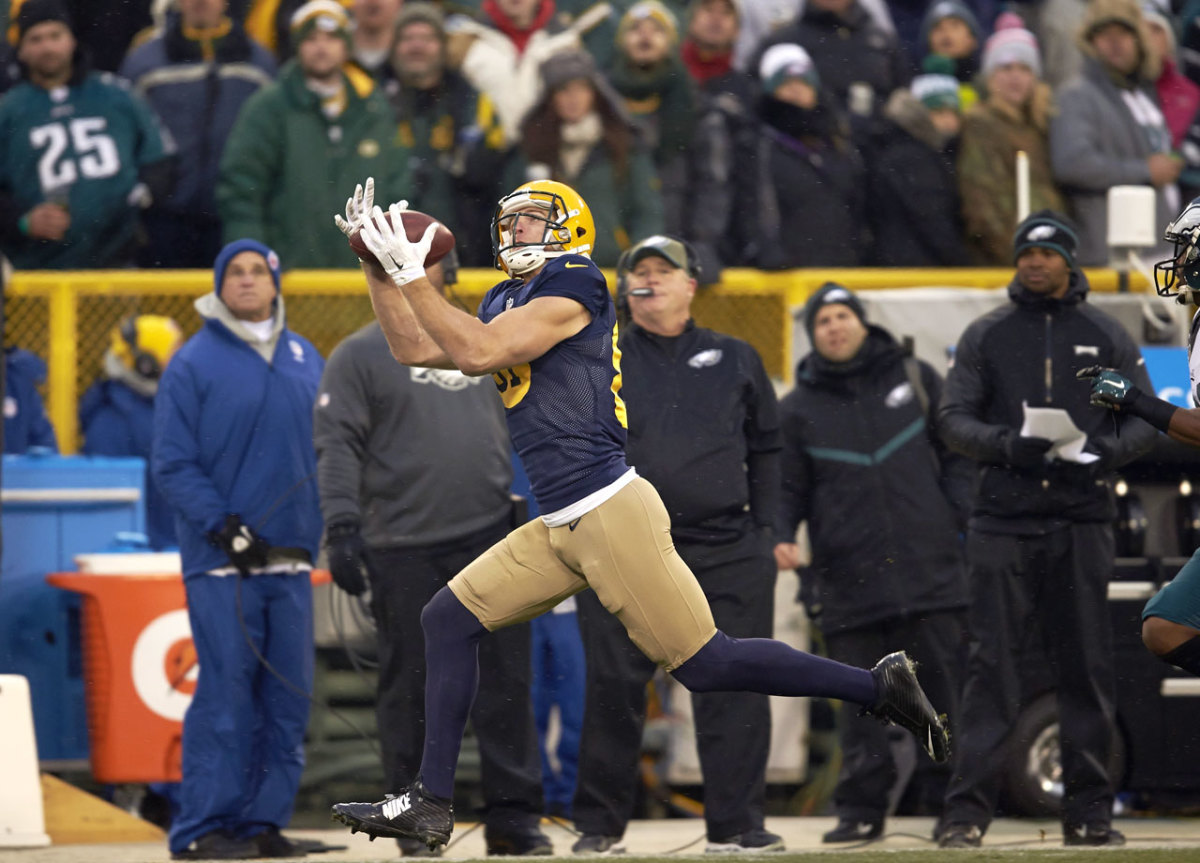
Receiving: 70 receptions, 1,119 yards, 10 TDs
TE: Rob Gronkowski (NE)
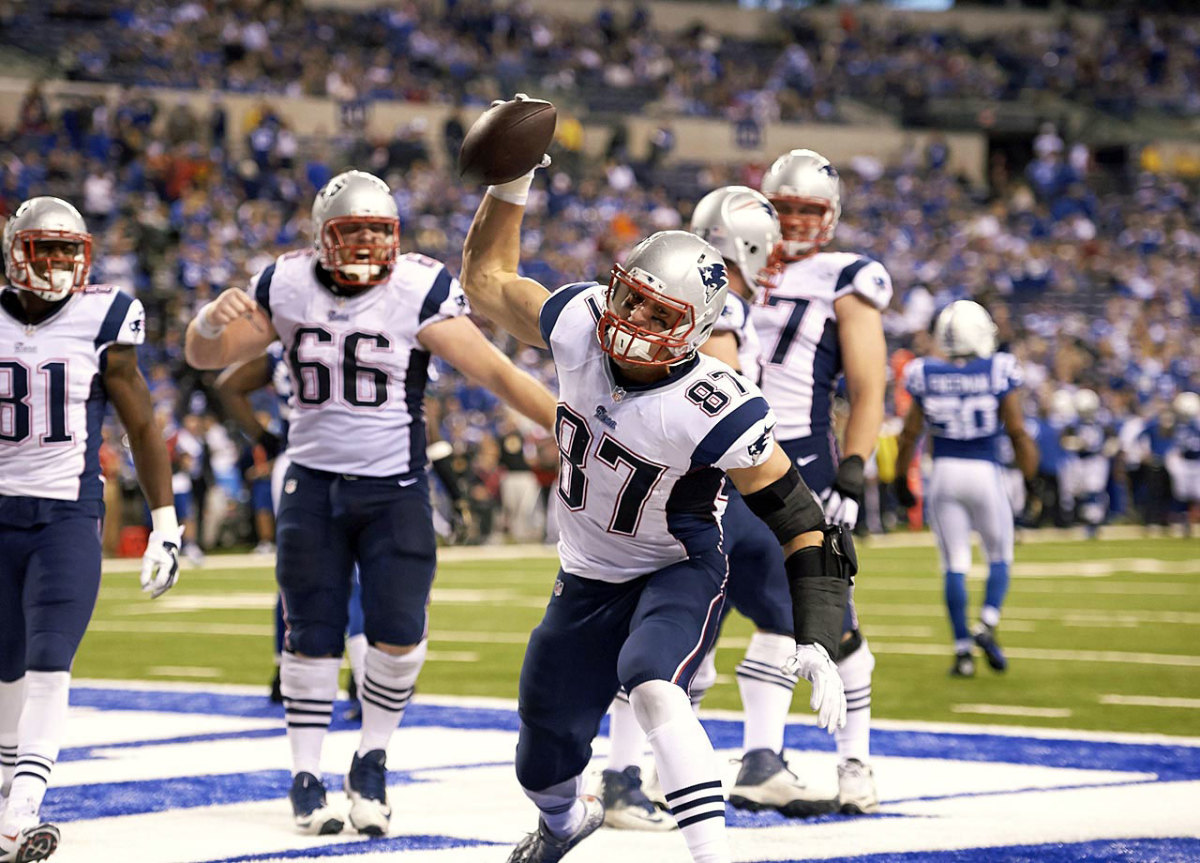
Receiving: 65 receptions, 910 yards, 9 TDs
K: Cody Parkey (PHI)
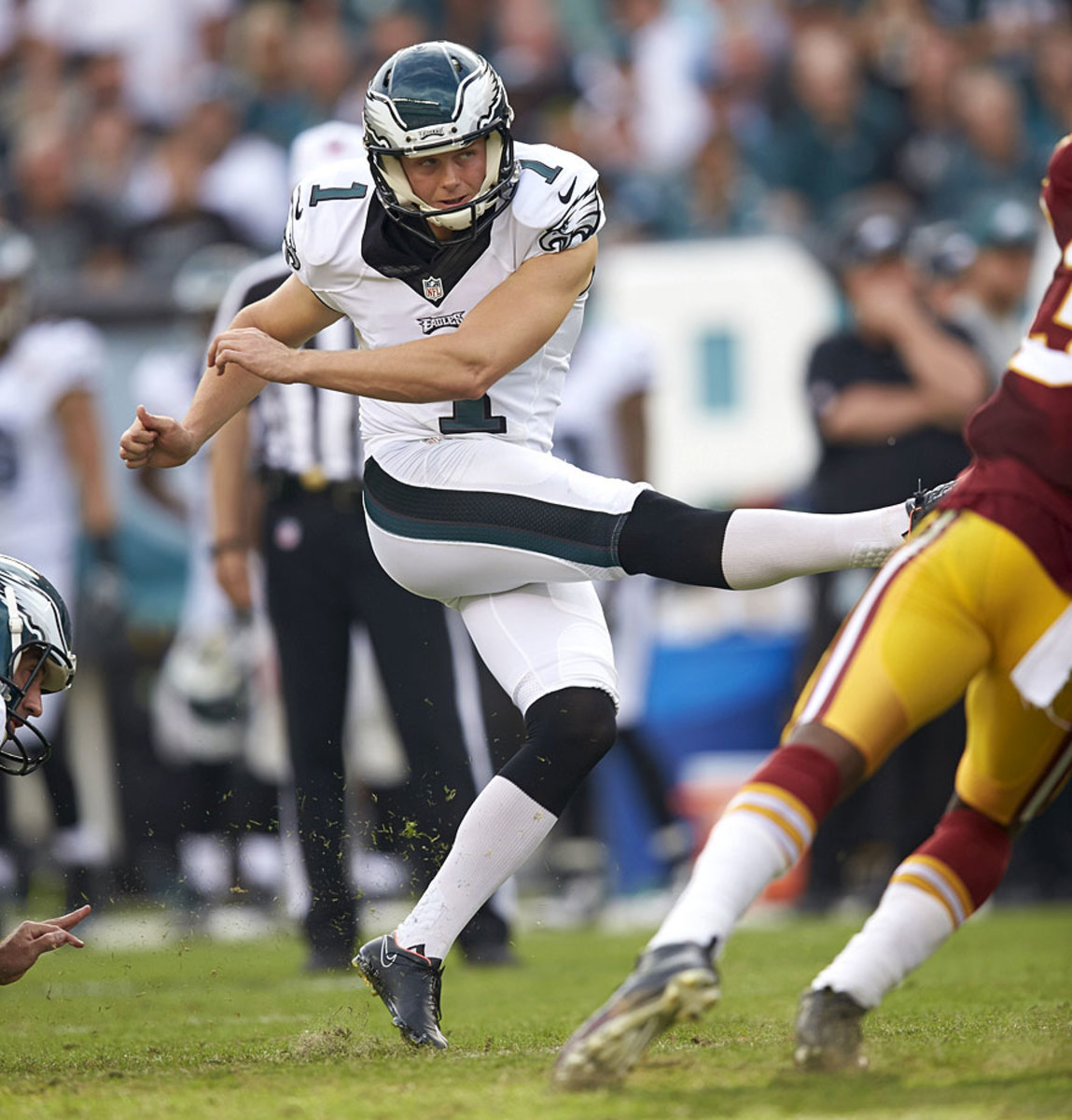
Made 27 of 29 Field Goals (4-of-4 50+ yards) and 42 of 42 Extra Points
DEF/ST: Philadelphia Eagles
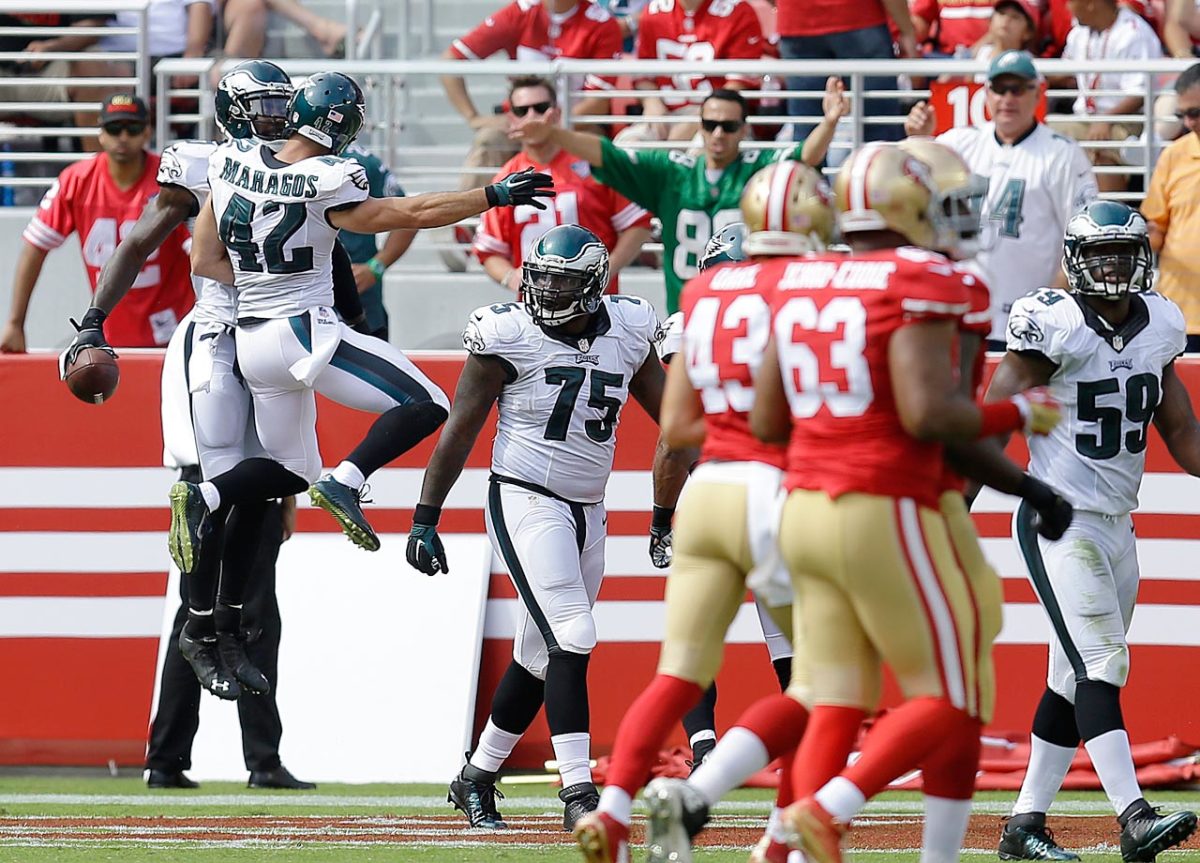
42 sacks, 71 TFL, 10 Int, 12 Fumbles Recovered, 5 Blocked Kicks, 6 DEF TDs, 4 Return TDs
Wide receivers: Not who we thought they were?
Heading into the 2014 season, the top-10 receivers by average draft position all looked rock solid at their draft slots, but you could argue that only six delivered as expected.
Antonio Brown, Demaryius Thomas, Jordy Nelson, Dez Bryant, Randall Cobb and Alshon Jeffery all boast great season-long numbers. Brown, Thomas, Nelson and Bryant have been studs, scoring at least 14 points per game. Cobb and Jeffery have trailed them a bit, but they also trailed them in average draft position. All of the six met or exceeded expectations in 2014.
Target Report: Brown, Nelson keep on racking up catches for owners
Julio Jones and A.J. Green, seemingly joined at the hip since their days in the SEC, had similar 2014 campaigns. On a per-game basis, Jones is ranked sixth among receivers, while Green is seventh. However, both receivers have dealt with injuries this season, especially Green, who missed four games. Jones, meanwhile, packed all his production into the first and last months of the season. From Week 4 through Week 11, he surpassed 10 fantasy points just twice. Basically, he was the anti-Antonio Brown.
Finally, Calvin Johnson and Brandon Marshall busted, though to different degrees. Johnson missed three games completely, and had two others compromised by his ankle injury. Even when he did play, he had an out-of-character season, scoring fewer than 10 points in five of the games during which he was fully healthy, and fewer than six three times.
Marshall was an unmitigated bust, and was the only player completely taken down by the tumult in Chicago. He finished the season with 61 receptions, 721 yards and eight touchdowns in 13 games. The touchdowns look impressive on the surface, but he had five of them in the first four weeks of the year. From Week 5 through Week 14, he had more than seven points just three times.
Overall, the top-tier wide receivers came through for their owners this season. Just don’t try to tell that to a Johnson or Marshall owner.
You can win with any strategy, so long as you pick the right players
Keep this in mind when the first fantasy football articles for 2015 start cropping up. You will see no shortage of columns exhorting that this strategy or that one is the very best, and the surest to lead to fantasy success. “Wait on your quarterback,” cries one. “No, take a QB early,” counters another. “Go zero-RB, running backs are as fungible as it gets,” insists still another. It can be dizzying if you don’t have your own plan of attack.
You have to have a strategy to help you sidestep some of the landmines planted in any draft. However, no overarching strategy is the be-all, end-all. The bottom line is that any strategy can work if you find the right players for that strategy.
Let’s say you went zero-RB this year. No matter where you were picking in your draft, average draft position numbers tell us that you could have ended up with Demaryius Thomas, Jordy Nelson, Rob Gronkowski and Andrew Luck with your first four picks. You could have filled in with the likes of Joique Bell, Rashad Jennings and Lamar Miller, and had the best team in your league. At the same time, you could have taken Jimmy Graham, Brandon Marshall, Vincent Jackson and Matthew Stafford with those first four picks, and completely fallen apart.
Conversely, what if you went against the zeitgeist and stuck with the age-old RB-RB strategy. Well, you may have ended up with two of Murray, Bell and Foster. Or you could have been picking at the beginning of the first round and landed Jamaal Charles in the first and Bell in the second. At the same time, you could have selected McCoy and Giovani Bernard. Or Peterson and Zac Stacy.
The point is that there are countless strategies at fantasy owners’ disposal. Spend less time debating which one is the best, and put more time into player evaluation. The only process that really matters is the one that leads you to the best players.
Say it with me: I won’t take a defense until one of the last two rounds
The top-five fantasy scoring defenses in 2014 were as follows: Philadelphia, Buffalo, Houston, St. Louis, Arizona. The next five were the Patriots, Ravens, Dolphins, Browns and Colts. A few teams are rather conspicuous by their absence, no?
The Seahawks still had a great real-life defense, but that doesn’t always translate to the fantasy world. They ranked 15th. The Panthers fell apart in real life and fantasy, and finished the season as the 28th-ranked unit. San Francisco checked in at 16th, Denver at 20th and Cincinnati at 26th.
There is negative value in using a high pick (read: anything higher than one of your last two picks) on a defense. Season after season it is proven that the best strategy for your defense slot is to hop on the carousel and stream a new unit with a great matchup every single week. Do not forget this lesson in August 2015.
[pagebreak]
The superflex format should be the standard format
With the proliferation of the two-headed running back and domination of the passing game in today’s NFL, there are more fantasy-relevant players than ever. Rashad Jennings, Tre Mason and Jonathan Stewart are all ranked outside the top-25 running backs. Vincent Jackson isn’t a top-30 wide receiver. Neither is Keenan Allen. From start to finish, those guys haven’t scored as RB2s or WR3s, but they all have a place in the fantasy world.
The issue is even more pronounced at the quarterback position. Matthew Stafford and Tony Romo aren’t top-12 quarterbacks. These are players who should matter in fantasy leagues, but the could conceivably be called non-starters when it’s all said and done.
It’s time to make sure all of those guys are regular fantasy starters. With more players in your starting lineup, anomalous performances have a less dramatic effect. By starting two quarterbacks, you put more value in the most important position in the league. It makes formulating a draft and auction strategy more challenging, rather than rolling out the same, tired moves from previous years. Most importantly, the more starting spots you have in your league, the more skill rises to the top. That’s something every competitive fantasy owner should want.
• WATCH: Jordy Nelson makes crazy-good catch over Bucs' defender
The season is short, but not too short for a little patience
After the first month of the season, the two players causing the most trepidation in the fantasy community were likely Demaryius Thomas and Tom Brady. The Broncos played just three games in September, and Thomas had a total of 13 receptions for 141 yards and one touchdown in the season’s first month. Brady, meanwhile, headed into the fifth week of the year with a beatdown at the hands of the Chiefs. Through four weeks, Brady had 791 yards, 5.77 yards per attempt, four touchdowns and two interceptions.
Three months later, all was forgiven. Thomas had 226 yards and two scores in Denver’s fourth game and hasn’t looked back. He went on seven-game 100-yard streak, is up to 96 catches for 1,389 yards and 11 touchdowns. He’s currently the second-ranked fantasy receiver, trailing only Antonio Brown.
Brady and the Patriots waxed the Bengals in Week 5, with the quarterback throwing for 292 yards and two scores. Even with his dreadful start to the season, he’s the No. 7 overall quarterback with 4,029 yards, 33 touchdowns and nine picks.
The fantasy regular season may only be 13 weeks long, and there’s something to be said for a sense of urgency. At the same time, patience frequently pays, especially with your stars.
2014 Fantasy Football All-Pro Team
QB: Andrew Luck (IND)

Passing: 4,011 yards, 34 TDs, 11 Ints | Rushing: 213 yards, 2 TDs
RB: DeMarco Murray (DAL)

Rushing: 1,427 yards, 8 TDs | Receiving: 44 receptions, 343 yards
RB: Le’Veon Bell (PIT)

Rushing: 1,046 yards, 3 TDs | Receiving: 65 receptions, 643 yards, 2 TDs
WR: Antonio Brown (PIT)

Receiving: 96 receptions, 1,258 yards, 11 TDs, 1 2PT | Rushing: 13 yards | Passing: 20 yards, 1 TD
WR: Demaryius Thomas (DEN)

Receiving: 88 receptions, 1,255 yards, 10 TDs, 1 2PT
WR: Jordy Nelson (GB)

Receiving: 70 receptions, 1,119 yards, 10 TDs
TE: Rob Gronkowski (NE)

Receiving: 65 receptions, 910 yards, 9 TDs
K: Cody Parkey (PHI)

Made 27 of 29 Field Goals (4-of-4 50+ yards) and 42 of 42 Extra Points
DEF/ST: Philadelphia Eagles

42 sacks, 71 TFL, 10 Int, 12 Fumbles Recovered, 5 Blocked Kicks, 6 DEF TDs, 4 Return TDs
The late-round quarterback is still alive and well
This year, there was more support than usual for using a top pick on a quarterback. The seeming bankability of Aaron Rodgers, Peyton Manning and Drew Brees made them all safe picks in the first or second round. While that triumvirate did deliver for their owners, they have to outperform the field by a magnitude of two or three to justify their draft-day prices.
Meanwhile, the late-round quarterback was a strong as ever this season. Andrew Luck, the No. 5 signal caller by average draft position, was the No. 1 overall quarterback. Russell Wilson, Ben Roethlisberger, Philip Rivers and the recently deposed Jay Cutler were all selected after 10 quarterbacks were off the board and outside the first 80 picks in a typical draft. All were top-10 players at the position in 2014, with Wilson checking in at No. 4, behind only Luck, Rodgers and Manning.
There’s no doubt that quarterbacks like Rodgers and Manning deserve to be at the top of the rankings. After the season he just had, Luck will be in that group next year, too. As we already discussed, many different strategies work if you can find the right players. Make sure you have the late-round quarterback on your radar next season.
Rob Gronkowski is your first-round tight end in 2015
This year, Jimmy Graham was seen as the top tight end and a surefire first-round pick. He posted another strong season, though one not quite worthy of a first-round selection next year. Instead Gronkowski, who should also be on the shortlist among the possible fantasy MVPs, should be drafted in the first round
Through Week 16, Gronkowski had 82 catches for 1,124 yards and 12 touchdowns, coming out to an average of 12.29 points per game. Remember, Gronkowski wasn’t even really himself until the fifth week of the season, which just happened to coincide with the Patriots finding their stride offensively. Gronkowski was easily the No. 1 tight end this season and is among the most valuable commodities in fantasy leagues this year.
Gronkowski will be just 26 years old next year. Injuries are always a possibility with his breakneck style, but when he’s healthy he’s one of the most dangerous players in the league. Once the elite backs and receivers are off the board, Gronkowski will be the best player available. That should make him a late-first-round pick in 2015.
Le’Veon Bell is your top overall player next season
After the monster season he put up this year, Bell will rightly be considered worthy of the first overall pick in your draft. He didn't waste anytime getting started this season, running for 109 yards and a touchdown and catching six passes for 88 yards in the first week of the season.
An oral history of the 1974 Steelers, the team that launched a dynasty
As we stated at the beginning of the column, Bell was a model of consistency this year, scoring in double digits all but one week. He showed up when it mattered most, putting up nearly 80 points combined over the three playoff weeks. He did everything his owners could have asked for and more, and surpassed DeMarco Murray for the top spot among running backs in Week 16.
The second-year player out of Michigan State completely revamped his running style this season. He lost some weight, and in the process became a shiftier, more explosive back. Bell was again one of the most dangerous dual threats in the league, running for more than 1,300 yards and catching 77 passes for 774 yards. He can do it all for his owners, and has the consistency and big-game ability that you look for in a top pick.
When the 2015 season begins, Bell will be just 23 years old. After a foot sprain cost him a handful of games early in his rookie season, he has stayed completely healthy. In short, Bell is everything a fantasy owner would want, and he belongs atop draft boards next year.
